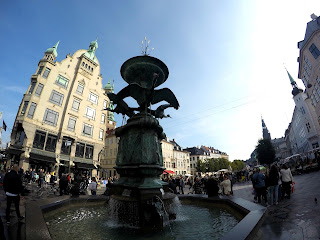Bisected by the Dnieper River and known for its religious architecture and monuments, the Ukrainian capital seems to have shot up around many different hills meaning that whichever direction you choose, it's likely you'll be fighting a reasonably steep gradient in order to take in its many sights.
This latest trip came as the newest installment in my friendship group's quest to explore as much of Eastern Europe, and as many of its football derby matches as possible.
Sadly due to various factors and the late stage at which it was planned, the trip was far too brief to be able to pass an authoritative judgment on Kyiv as a city break, but what I can do is speak incredibly highly of what we experienced in two afternoons and three evenings.
Our hostel was located at the foot of Andriivs'kyi Descent, a winding and cobbled street which offers a throwback to 'old Kyiv', complete with market stalls selling all kinds of gifts and traditional dress.
At the top of the descent is the grand St Andrew's Church and also located not so far away is the strikingly shiny St Michael's Golden-Domed Monastery, something I was only able to witness briefly from a passing car due to our time constraints.
We did however find time to enjoy wandering around Kyiv's streets and rubbing shoulders with locals at the not so tourist trodden street markets.
As previously touched upon, Kyiv is a mecca for fans of religious architecture, with its many orthodox structures cutting all kinds of shapes into the city's skyline, but for me the most moving sight was Maidan and Republic Square.
Prior to visiting Kyiv, I watched the documentary Winter on Fire, a production that captured how a civil rights movement erupted after a student protest escalated into a violent revolution which eventually resulted in the resignation of the country's president.
Thousands of protesters set up camp at Republic Square unhappy with President Yanukovych's decision to turn his back on EU talks and align himself closer to the Russian Government.
Following the loss of many lives at the hands of Government forces, the staunch will of those who went out onto the street to fight for their futures prevailed and President Yanukovych left his post and fled to Russia.
Standing at an open space that only a few years ago was the violent scene of such a poignant period of time in the country's history was moving and a reminder that human beings and ordinary people shouldn't be underestimated, particularly at a time of such EU related turbulence and uncertainty here in the UK.
Finally, and somewhat naturally, after a walk around the historic neighbourhood of Podil, our trip was rounded off with a football match, which in truth, was a somewhat strange experience.
Sitting just off of Khreshchatyk Street, Kyiv's main boulevard, is the Valeriy Lobanovskyi Dynamo Stadium.
The stadium is named after the legendary manager who for many years took charge of Dynamo Kiev, the country's most successful team and previously a European football powerhouse.
These days Dyamo play at the glistening Olimpiyskiy instead of the Lobanovskyi, while the Lobanovskyi hosts Dyamo's reserves and a number of smaller teams, despite Dynamo still owning the ground and its badge being displayed around the ground.
One of those teams are Arsenal Kiev, a team that has been formed, dissolved and reformed in true Eastern European fashion.
Although they were the home team I was only able to count a handful of Arsenal fans, with the stands dominated by Dynamo supporters, who as far as I'm aware remain the country's best supported club.
As is often the case in Eastern Europe, the quality on the pitch is lacking due to the rich getting richer in the west thus creating an increasingly uneven playing field, in financial terms anyway.
Dynamo were able to run out 1-0 winners despite playing the last 20 minutes with nine men, the goal sparking spectacular scenes in their ultras section which saw an abundance of flares lit, hundreds of blokes stripping to the waist on a cold night and a few fireworks let off for good measure.
The stadium itself, although dated, lies behind a grandiose gate and is a throwback to the stadiums of years gone by. For me, the highlight of these trips are seeing the pyrotechnic displays and non-stop chanting of ultras and contrasting it to the sanitised atmosphere of football here in the UK where I am not even able to get a bottle top into the stadium.
So with a plethora of sights and iconic buildings, cheap prices and a pumping nightlife, there are many reasons to venture to Kyiv and Europe's far eastern reaches.
All in all, although due to time restraints we were unable to visit everything in the city we wanted to, it was a thoroughly enjoyable yet brief visit and a perfect stop-gap to keep me going until my dream trip to South America next month.
























































